60th Anniversary of Tristan's 1961 Volcano, Part 1
Issue date: 3rd November 2021
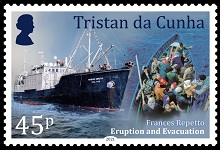 |
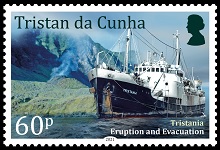 |
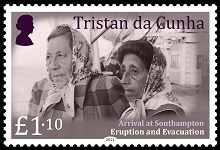 |
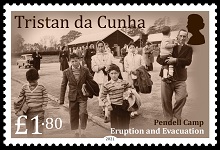 |
| 202109 | Mint Stamps (45p, 60p, £1.10, £1.80) | £3.95 | Shop > |
| 202110 | First Day Cover (with 45p, 60p, £1.10, £1.80 stamps) | £5.15 |
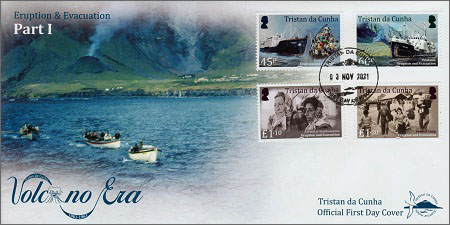
Eruption and Evacuation
The volcanic eruption on Tristan da Cunha in October 1961 was the defining event in the island's history, because the entire community was forced to evacuate their island. After two months of worrying earth tremors, the entire population sought shelter at the Potato Patches on the 9th October as a threatening mound grew and threatened to erupt immediately above the village. Overnight the mound displayed volcanic activity, pushing up hot cinders and emitting sulphurous gases. On the following fateful day, Tuesday 10th October, the entire population of 264 islanders and 31 expatriates were evacuated safely off the island in miraculously calm conditions. Longboats ferried them to the fishing vessels, Tristania and Frances Repetto, which took them to Nightingale Island for another uncomfortable night. By now HMS Leopard was speeding from South Africa, but the community did not have to wait for its arrival, as the Dutch liner, Tjisadane, due to call to pick up passengers that day and with plenty of spare berths, loaded all aboard to complete the evacuation of the islands on 11th October.
Administrator Peter Wheeler stayed behind and with crew members from the fishing boats went back ashore on Tristan the following day to secure valuables, including cash, firearms, and stamps. HMS Leopard completed a salvage operation over the next two days. Tjisadane arrived in Cape Town to be welcomed by the world's media on Monday 16th October. Islanders were treated to generous hospitality and showered with gifts from locals anxious to befriend and assist the refugees who were now international celebrities. Soon islanders and expats boarded the RMS Stirling Castle which departed Cape Town on Friday 20th October for the next stage of an epic journey that would take 24 days and cover 15,408 km or 9,578 miles.
Hasty temporary arrangements were made for the refugees to stay at the disused Pendell army camp in Surrey. By the end of October, lava had destroyed the fishing factory and the island's main landing beach. It was assumed when RMS Stirling Castle docked in Southampton on 3rd November that Tristan da Cunha would be abandoned as a home for the islanders, and that their future lay in the UK. It would take another five months for this to be challenged, and so there was a sombre mood as a procession of coaches transported the Tristan refugees to Surrey, because they feared their way of life in the South Atlantic was lost forever.
Description of the Stamps
45p - The photograph by Geoffrey Dominy, captain of the Frances Repetto, shows evacuees being carefully offloaded from aboard the Frances Repetto to a waiting Tristan longboat off Nightingale Island on 11th October 1961, prior to being transferred to the Dutch liner Tjisadane.
60p - A second photograph taken by Geoffrey Dominy on 10th October 1961 shows the volcanic cone above the Tristan village emitting sulphurous smoke behind a grass-covered mound which arose the previous day. Superimposed on the photograph is an image of the Tristania, captained by Morris Scott.
£1.10 - A British Pathé photograph shows Tristan islanders Sophie Green and Edith Repetto on the deck of the RMS Stirling Castle as it arrives in Southampton on 3rd November 1961.
£1.80 - The Rogers family arriving at Pendell Camp, Surrey on 3rd November 1961.
First Day Cover - A third photograph from Geoffrey Dominy from aboard the Frances Repetto taken on 10th October 1961 and showing loaded longboats full of evacuees being ferried from Little Beach to the awaiting fishing boats. Behind is the newly formed volcanic cone emitting smoke situated above the Settlement to the right and the fishing factory just visible on Big Beach far left.
This third Dominy photograph forms part of the cover of the book: "Nothing Can Stop Us - Tristan da Cunha's volcanic eruption and how its people handled their future" to be published by the Tristan da Cunha Association in November 2021. The book also tells the wider story of the island community, including background geographical information and history to the present day.
Technical Specifications from Pobjoy Mint Ltd.
| Photographs: |
45p, 60p & FDC - Courtesy Joan Umpleby £1.05 - British Pathé £1.80 - Courtesy Mike Faulds |
||
| Designer: | Bee Design | Printer: | Cartor |
| Stamp size: | 42 x 28mm | Perforation: | 13¼ x 13½ per 2cms |
| Process: | Lithography | Sheet Layout: | 10 |
| Production Co-ordination: | Creative Direction (Worldwide) Ltd | ||
The Tristan Post Office would like to acknowledge the kind help and assistance of Mike Faulds and Richard Grundy.
